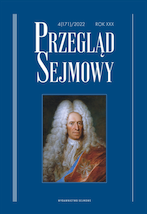Prezydent w systemie politycznym Wietnamu. Analiza porównawcza założeń ustrojowych wietnamskich konstytucji
The president in the political system of Vietnam. A comparative analysis of the systemic assumptions of the Vietnamese constitutions
Author(s): Małgorzata PietrasiakSubject(s): Politics / Political Sciences, Law, Constitution, Jurisprudence, Political Theory, Geopolitics
Published by: Kancelaria Sejmu
Keywords: Vietnam; president; political system; Constitution of Vietnam; doi moi; Communist Party of Vietnam
Summary/Abstract: The analysis undertaken in the article concerns the position of the president in the political system of Vietnam. The analysis begins with the period of formation of Vietnamese statehood after colonial era. In 1946, Vietnam’s first constitution was adopted. Following the abdication of Emperor Bao Dai, the first president acting under it was Ho Chi Minh. The constitution gave the president considerable powers which were amended in subsequent constitutions. Vietnam’s political system was strongly influenced by the international situation at each stage ending with adoption of a new constitution. Beginning with the second constitution, in 1959, the Communist Party of Vietnam remained the leading force in the state. The victory with the United States of America sealed this state of affairs. A feature of the entrenched party system in Vietnam was that the ruling party based on collegial leadership. This collegial leadership also applied to the president’s position in the political system. It was no longer the president himself, but the collegiate bodies that indicated the directions of development of the socio-economic system. The glue remained the Communist Party of Vietnam, which controlled, supervised and fed these collegiate bodies. Changes came after the doi moi reforms, when it was decided to liberalise the economy, but with limited changes to the political system. The entire current ruling elite of the country comes from the CPV. The last constitution was adopted in 2013, while personnel decisions were made at the 13th Congress of the CPV – a return to a power-sharing structure based on the “four pillars”: the secretary general of the party, the president, the prime minister and the speaker of the National Assembly.
Journal: Przegląd Sejmowy
- Issue Year: 2022
- Issue No: 4
- Page Range: 101-124
- Page Count: 24
- Language: English, Polish

